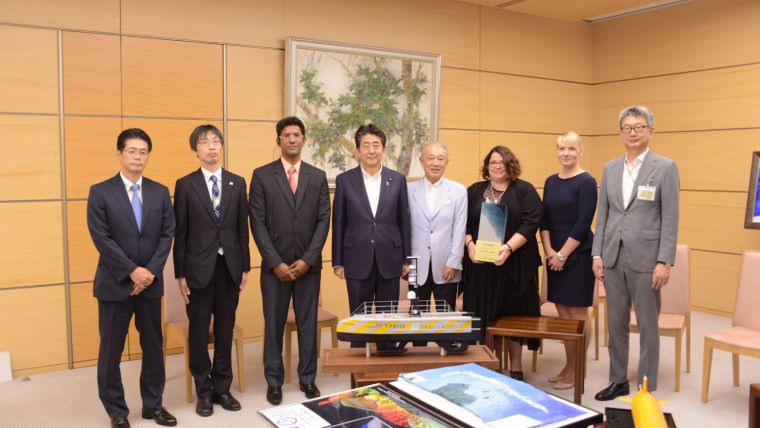Ocean Discovery XPRIZE Winners Talk Tech in Tokyo with Japanese PM
Prior to being awarded the four million dollar grand prize in the Shell Ocean Discovery XPRIZE this May, the members of the international GEBCO-Nippon Foundation Alumni Team had found precious few opportunities to all meet face to face. For much of their three-year journey in the competition, communication was carried out remotely through email and Skype. A recent visit to Tokyo, however, offered a chance to sit down together and plan their next steps as a team and a broader network of alumni – as well as discuss the importance of ocean mapping with the Japanese Prime Minister.
Meeting the PM
On 18 September, selected members of the team met with Prime Minister Shinzo Abe to talk about the technology that they developed for the competition, and how their model of international scientific cooperation can help to map the gaps that still remain in our understanding of the ocean floor.
Philanthropic Organization
They were introduced to the Prime Minister by Yohei Sasakawa, Chairman of The Nippon Foundation, Japan’s largest private philanthropic organization, which supported the team’s entry. They were also accompanied by Mitsuyuki Unno, Executive Director of the Ocean Affairs division at The Nippon Foundation, who followed the team’s progress closely throughout the competition.
Definitive Map of the World’s Ocean Floor
The team presented the PM with a gift of a framed copy of the General Bathymetric Chart of the Oceans (GEBCO) 2019 – the most recent version of the definitive map of the world’s ocean floor, compiled using data contributed by The Nippon Foundation-GEBCO Seabed 2030 Project. They also showcased scale replicas of the vessels that they used and 3D visualisations of the data that they collected during the competition.
Deep-water Multibeam Echosounder
The GEBCO-NF Alumni prevailed over competitors from around the world to win the Ocean Discovery XPRIZE with their concept for fast, efficient, and cost-effective seafloor mapping. Their entry utilised the SEA-KIT Unmanned Surface Vessel (USV) Maxlimer, alongside the Kongsberg Maritime HUGIN Autonomous Underwater Vehicle (AUV) System, rated to operate at depths of up to 4,500 metres in Round 2, leveraging new and existing technologies to optimal effect. SEA-KIT was able to autonomously launch and recover the Kongsberg Maritime HUGIN AUV, map the seabed using a deep-water multibeam echosounder, and act as a communication link during the AUV’s subsea survey operations.
‘No Way, No Chance’
“The XPRIZE requirements – for resolution, depth, timeframe, and using unmanned technology – are, on their own, easy to achieve using modern mapping techniques,” explains Dr Karolina Zwolak of Poland, who graduated from UNH in 2013. “When combined together, however, that is when they become a challenge. All the experts we spoke to said ‘No way, no chance’ – this was the challenge we had to overcome.”
Sophisticated Bathymetric Maps
The Team applied innovative approaches to data processing, with a newly developed automated workflow, remote data processing, and a rapid data-to-information pipeline using web services to allow global access to data within the competition timelines. Masanao Sumiyoshi, from the Class of 2017, describes how the team “achieved highly sophisticated bathymetric maps very quickly, and the diversity of backgrounds and cultures amongst the team drove us strongly to create our innovative solution.”
Expand Capabilities for Ocean Mapping
“We really want to capture the momentum generated by winning the Ocean Discovery XPRIZE competition," says Hadar Sade of Israel, who graduated from the UNH programme in 2011 and was part of the team’s executive management. “We now have the tools and capacity to turn our achievements into something new and drive forward our vision to expand capabilities for ocean mapping, while supporting international and regional efforts together with The Nippon Foundation, GEBCO, and the Seabed 2030 initiative.”
Goals of Seabed 2030
“International collaboration was the cornerstone of the GEBCO-NF Alumni Team concept, with team members communicating with one another all over the world to coordinate our activities and process the data we collected”, said Dr Zwolak. “This model must be developed to support the goals of Seabed 2030 and help us to explore, manage, and protect our oceans on a truly global scale.”
Training Programme
The team was managed by Dr Rochelle Wigley (US) and Dr Yulia Zarakskaya (Russia), and also included Training Programme alumni Dr Evgenia Bazhenova (Russia), Aileen Bohan (Ireland), Dr Mohamed Elsaied (Egypt), Andres Fitzcarrald (Peru), Tomer Ketter (Israel), Christina Lacerda (Brazil), Jaya Roperez (Philippines), Azmi Rosedee (Malaysia), Ivan Ryzhov (Russia), and Neil Tinmouth (South Africa).
The team’s SEA-KIT vessel USV Maxlimer was named after UNH Nippon Foundation/GEBCO Postgraduate Training Programme alumna Maxlimer Anziani Vallee, who sadly passed away following a car accident in January 2017.
International Efforts
The Nippon Foundation is also jointly spearheading international efforts to map the entirety of the world’s ocean floor by the end of the next decade. The Nippon Foundation-GEBCO Seabed 2030 Project was launched by Mr Sasakawa at the UN Oceans Conference in 2017, and more than 100 organizations are now contributing to the goal of producing a complete map – vital to exploration and discovery, marine resource management, and climate science.

Value staying current with hydrography?
Stay on the map with our expertly curated newsletters.
We provide educational insights, industry updates, and inspiring stories from the world of hydrography to help you learn, grow, and navigate your field with confidence. Don't miss out - subscribe today and ensure you're always informed, educated, and inspired by the latest in hydrographic technology and research.
Choose your newsletter(s)
























